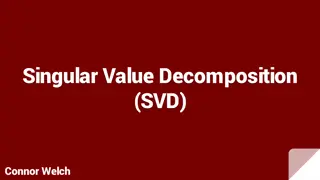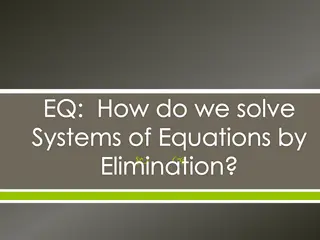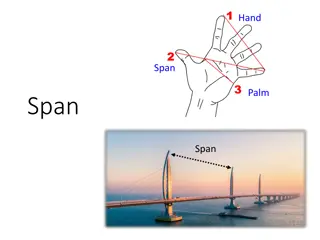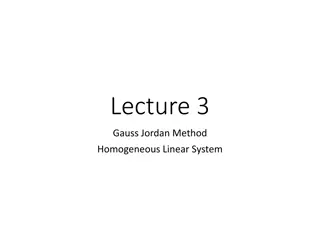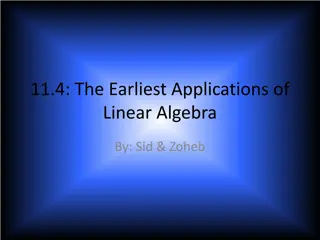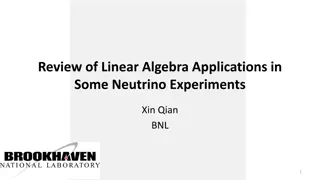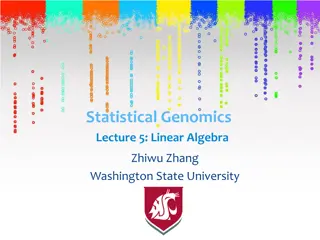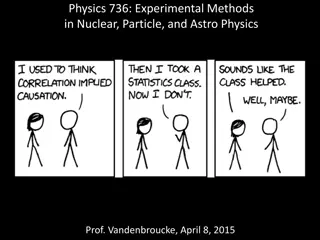Understanding Gaussian Elimination Method in Linear Algebra
Gaussian Elimination and Gauss-Jordan Elimination are methods used in linear algebra to transform matrices into reduced row echelon form. Wilhelm Jordan and Clasen independently described Gauss-Jordan elimination in 1887. The process involves converting equations into augmented matrices, performing row operations to simplify the matrix, and obtaining a reduced row echelon form. An example system solving process is also demonstrated step by step.
Download Presentation

Please find below an Image/Link to download the presentation.
The content on the website is provided AS IS for your information and personal use only. It may not be sold, licensed, or shared on other websites without obtaining consent from the author. Download presentation by click this link. If you encounter any issues during the download, it is possible that the publisher has removed the file from their server.
E N D
Presentation Transcript
Mustansiriyah University College of Engineering Computer Engineering Dept Mathematical analysis II GAUSS JORDAN ELIMINATION METHOD Lect. Sarmad K. Ibrahim
GAUSS JORDAN METHOD Some authors use the term Gaussian elimination to refer only to the procedure until the matrix is in echelon form, and use the term Gauss-Jordan elimination to refer to the procedure which ends in reduced echelon form. In linear algebra, Gauss Jordan elimination is an algorithm for getting matrices in reduced row echelon form using elementary row operations. It is a variation of Gaussian elimination.
HISTORYABOUT GAUSS JORDAN METHOD it is a variation of Gaussian elimination described by Wilhelm Jordan in 1887. as However, the method also appears in an article by Clasen published in the same year. Jordan and Clasen probably discovered Gauss Jordan elimination independently.
HERE ARE THE STEPS TO GAUSS-JORDAN ELIMINATION: Turn the equations into an augmented matrix. Use elementary row operations on matrix [A|b] to transformAinto diagonal form. Make sure there are no zeros in the diagonal. Divide the diagonal element and the right-hand element (of b) for that diagonal element's row so that the diagonal element is equal to one.
Example 1 . Solve the following system by using the Gauss-Jordan elimination method. x + y + 2x + 3y 4x + 5z z = 5 + 5z = 8 = 2
Solution: following. The augmented matrix of the system is the 1 2 4 1|5 5|8 5|2 1 3 0 We will now perform row operations until we obtain a matrix in reduced row echelon form. 5 1 1 1 1 2 4 1 3 0 1|5 5|8 5|2 -2 0 1 3 2 4 0 5
1 1 1 5 1 1 1 5 0 1 3 -2 R3-4R1 0 1 3 -2 0 -4 -18 1 4 0 5 2
1 1 1 5 1 1 1 5 R3+4R2 0 1 3 -2 0 1 3 -2 0 -26 0 0 -4 1 -18 13
1 1 1 5 1 1 1 5 (1/13)R3 0 1 3 -2 0 1 3 -2 0 0 13 -26 0 0 -2 1
1 1 1 5 1 1 1 5 0 1 3 -2 0 1 4 0 R2-3R3 0 0 1 -2 0 0 1 -2
1 1 1 5 1 1 0 7 0 1 0 4 0 1 0 4 R1-R3 0 0 1 -2 0 0 1 -2
1 1 0 7 1 0 0 3 0 1 0 4 0 1 0 4 R1-R2 0 0 1 -2 0 0 1 -2
From this final matrix, system. It is we can read the solution of the X= 3 Y=4 Z=-2 Substitute x , y, z in system equation, if the right side = left side in three equation then the sol. is correct 3+4-2=5 2*3+3*4+5*(-2)=8 4*3+5*(-2)=2















